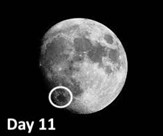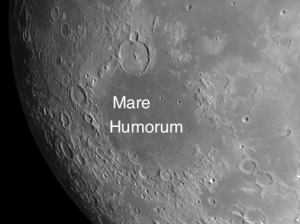The week of April 11-17 takes us from Day 10 to Day 16. This week we will highlight Mare Humorum on the moon, viewable on Tuesday evening.
 Mare Humorum: [SW/M6] The Humorum basin is one of the best examples of subsidence that you can see on the Moon. As the basin sank under the weight of its lavas, arcuate cracks, which can be easily observed in small telescopes, opened up on the east side around Hippalus and on the west side. The craters Doppelmayer, Lee, Hippalus, and Loewy tilted inward and their seaward rims sank beneath the lava flows which covered Mare Humorum.
Mare Humorum: [SW/M6] The Humorum basin is one of the best examples of subsidence that you can see on the Moon. As the basin sank under the weight of its lavas, arcuate cracks, which can be easily observed in small telescopes, opened up on the east side around Hippalus and on the west side. The craters Doppelmayer, Lee, Hippalus, and Loewy tilted inward and their seaward rims sank beneath the lava flows which covered Mare Humorum.
 Look closely at the Hippalus rilles just east of the mare. Notice how some of them plough through both mountain ridges and craters, and some are interrupted completely by small craters but continue on the other side. This gives you a clear indication of the sequence of activity. What features were in place before Humorum filled with lava and subsided? What features appeared after subsidence took place?
Look closely at the Hippalus rilles just east of the mare. Notice how some of them plough through both mountain ridges and craters, and some are interrupted completely by small craters but continue on the other side. This gives you a clear indication of the sequence of activity. What features were in place before Humorum filled with lava and subsided? What features appeared after subsidence took place?
======================
It is highly recommended that you get a copy of Sky and Telescope’s Field Map of the Moon, the very finest Moon map available for use at the telescope. It is available for $10.95 at www.skyandtelescope.com and on Amazon. All features mentioned in this blog will be keyed to the grid on the Field Map and will look like this: Plato: [NW/D9]
Credits:
Courtesy of Gray Photography of Corpus Christi, Texas
Lunar photos: NASA / USGS / BMDO / LROC / ASU / DLR / LOLA / Moon Globe. Used by permission
- Rupes Cauchy: A Best Known Fault on the Moon - July 22, 2024
- Moon Crater Schickard – Crater Floor has Stripes - July 15, 2024
- Moon Craters Langrenus and Vandelinus - July 8, 2024